| Published
on 7
Aug 2014 |
All rights reserved.
|
|
|
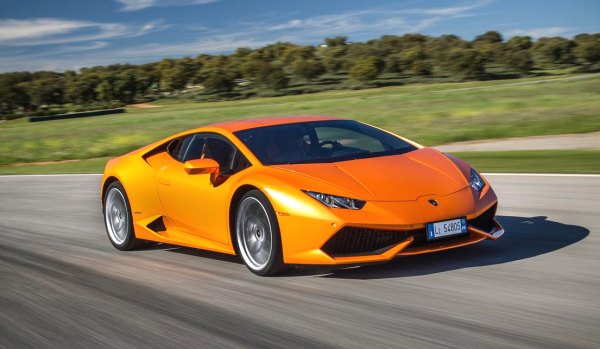 |
|
After
the long-running Gallardo dynasty we see a successor styled and
engineered in much the same format...
|
|
The idea of small
Lamborghini is not new. In the late 1960s, Ferruccio Lamborghini needed
a V8-powered car to supplement his V12 flagship models (Miura and
Espada) and provide the financial stability it desperately needed. It
was supposed to be cheaper and produced in larger quantity, i.e. 1000
units a year. The result was a mid-engined 2-plus-2-seater called Urraco launched in the early '70s.
Somehow, the car sold fewer than 800 copies because of all sorts of
problems – build quality, reliability, oil crisis and the financial
problem of Lamborghini itself. Sant'Agata built another 2 follow-ups in
the next decade, Silhouette and Jalpa,
but their market reception was no better. After 1988, it no longer
built small Lambos.
Things changed a lot when Audi acquired Lamborghini in 1998. The first
thing Audi wanted to do was to relaunch a small Lambo, one that would
beat Ferrari 360 Modena in performance as well as day-to-day usability,
and turn Sant’Agata to a profitable operation. It did. Thanks to strong
financial and engineering backing, not to mention the quality control
know-how and quality components supplied by its mother company, the Gallardo was incredibly well made for
something rolled off Sant'Agata. Well, not that the whole production
was carried out at Sant'Agata. Its aluminum spaceframe chassis was
actually built in Neckarsulm of Germany, and its V10 engine
was
also designed and built by Audi. This made business sense as the
Gallardo shared platform with Audi R8. Through unique styling and
tuning, Lamborghini managed to keep the raw edges it needed. In the 10
years from 2003, it sold 14,022 Gallardos, outselling Murcielago by 3.5
to 1 and accounting for half the accumulated production of Lamborghini
in its 50-year history. Ironically, it was also the first ever
profitable Lamborghini!
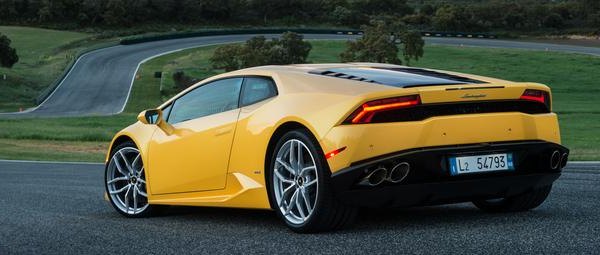 |
|
Its
wedge shape is set by Marcello Gandini's very first Countach – that's
more than 40 years ago, incredibly.
|
|
When the formula is successful, it is difficult to find the motivation
to try something new. Ferrari’s Luca di Montezemolo might be different,
but the German are not. That’s why after the long-running Gallardo
dynasty we see a successor styled and engineered in much the same
format. Yes, the new Huracan looks every bit like a Lamborghini. Its
wedge shape is set by Marcello Gandini's very first Countach – that's
more than 40 years ago, incredibly. However, perhaps we have got used
to that shape, or perhaps its sharp edges have been largely rounded
off, it no longer delivers that visual impact as I first saw the
Countach in person. I doubt if Mr. Lamborghini or Gandini would have
agreed with it. Lamborghini was supposed to be radical and
revolutionary. Now under the administration of Audi it has become
conservative, keeping the old shape and format unchanged and seeking
only small evolutions each generation. It sounds more Porsche than
Italian. I am puzzled…
Having said that, the Huracan is still an exotic design. It differs
from the Gallardo and Aventador in detailed features and surface
treatment. Its signature is the large piece of flat surface resting at
the top edge of the doors. It extends backwards, slips under the
blade-style C-pillar and disappears inside the engine intake. This
arrangement is simple and clever, even though I suspect it copied the
idea of the 2010 Lotus Esprit concept designed by Donato Coco. The rest
of the
car is slightly curvier and crisper than Gallardo. The slimmer
headlights and taillights are full LEDs. At the back, the engine lid is
covered with retro-style louvers, though I prefer the optional glass
window which puts the V10 engine in good display. Overall speaking, the
car looks beautiful, if not very original or innovative.
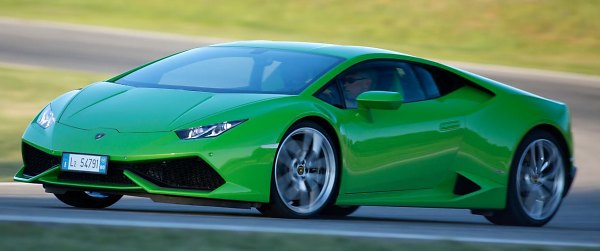 |
|
Lamborghini
was supposed to be radical and revolutionary. Now under the
administration of Audi it has become conservative...
|
|
The Huracan has grown a bit to give more interior space. Its overall
length and width have been extended by 114 mm and 24 mm respectively,
while the wheelbase is stretched by 60 mm. However, the roof still
stands at 1165 mm above ground, keeping the Lamborghini as the lowest
car in its class. Kerb weight has increased by 32 kg to 1532 kg, so it
continues to be heavier than Ferrari 458 and McLaren 650S. Considering
it has 4-wheel-drive system, that is acceptable I would say.
As before, you get into the cockpit through normal hinged doors,
something still separate it from the flagship V12 model. Entry is not
as difficult as the latter because its aluminum spaceframe chassis has
less prominent door sills. Once inside, you would find the space it
offers is pretty good – certainly more generous than Gallardo –
although outward visibility is still poor due to the fast-angle and
far-forward windscreen, the high waist lines and near non-existent rear
view. No complaints for the supportive bucket seats though.
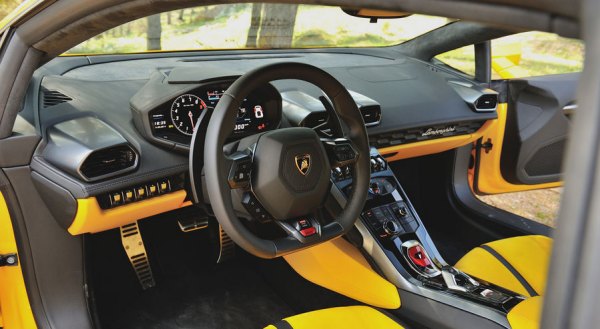 |
|
The
new interior design has really lifted the game...
|
|
While the interior design of Gallardo was boring, the Huracan has
really lifted the game. Inspired by the 1967 Marzal concept (the
forerunner of Espada), it employs
hexagonal elements as the main theme – the 4 air vents, instrument pod,
steering wheel, some buttons and decoration patterns on the glovebox.
Whether you like that depends on taste, but everybody should love the
12.3-inch reconfigurable TFT instrument for its clarity and
functionality, as is the effort to put many buttons on the steering
wheel for the ease of access. One of them is the new “ANIMA” (means
“soul” in Italian) switch, which mirrors Ferrari’s Manettino switch and
allows you to choose among Strada (street), Sport and Corsa (race)
modes, altering throttle response, exhaust noise, gearshift, steering,
damping, 4WD and traction control. Sadly, you can’t have different
settings for individual systems, say, Corsa gearshift and Strada
damping, unlike Ferrari or McLaren, so not always you can find the best
suitable settings.
Fire the engine and you will hear a familiar sound. That is because the
5.2-liter V10 is kept. However, thanks to a few modifications such as
new intake and exhaust, slightly higher compression (12.7:1 instead of
12.5:1), the adoption of dual-mode injection and automatic stop-start,
the
engine finds another 50 ponies and 15 pound-foot of torque, bringing
the total to 610 hp at 8250 rpm and 413 lbft at 6500 rpm. Meanwhile,
fuel consumption is reduced by 16 percent and CO2
emission drops from 351 to 290 g/km. Although it isn’t as free-revving
as Ferrari’s 4.5-liter V8 or as punchy as McLaren’s 3.8 twin-turbo V8,
the Lamborghini V10 still impresses with a linear power delivery and
enthusiasm for rev.
5000 rpm is just the beginning of its fun zone, which extends all the
way to 8250 rpm. The hard-edged exhaust note and pops and crackles on
overrun support this thrilling experience.
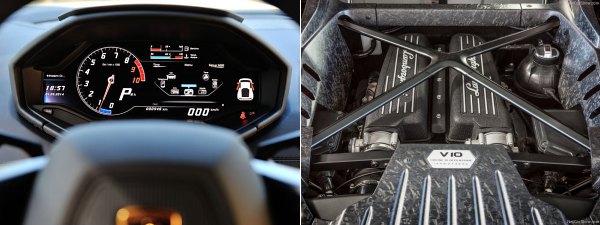 |
|
Fire
the engine and you will hear a familiar sound.
|
|
Although its quoted top speed stays at 202 mph, the Huracan feels
significantly faster than its predecessor, if not as fast as McLaren
650S. This is also evident in its 0-60 mph, which drops by half a
second to merely 3.1 seconds. Most of the improvement actually comes
from the R8-sourced 7-speed twin-clutch gearbox, which finally replaces
the notorious E-gear together with manual gearbox. It shifts quickly
yet smoothly thus is no longer the Achilles’ heel of Lamborghini. Big
brother Aventador must be jealous.
Of course, the big Lambo still enjoys the exclusive use of carbon-fiber
monocoque chassis. However, the cheaper Lambo is no ordinary either.
Its aluminum spaceframe construction is now strengthened with a
transmission tunnel and rear bulkhead made of carbon-fiber. That makes
it 50 percent stiffer torsionally and 10 percent lighter than the
full-aluminum chassis of Gallardo (take note, Ferrari). As before, the
chassis is assembled at Neckarsulm (where the next generation R8 will
be built alongside) and then shipped to Sant'Agata for final assembly.
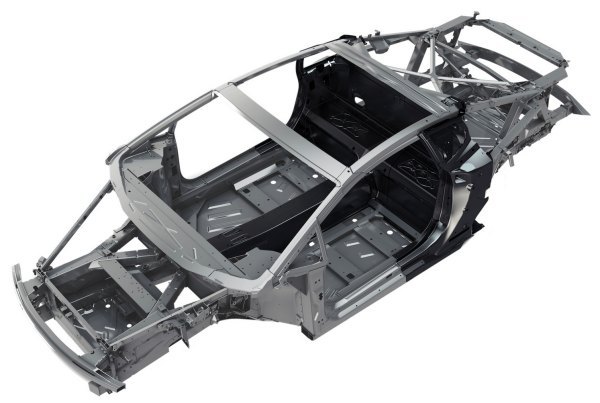 |
|
New
chassis reinforced by carbon-fiber transmission tunnel and rear
bulkhead.
|
|
Apart from chassis, the compulsory 4WD system is also improved.
Previously, Gallardo employed a passive viscous-coupling to engage the
front wheels only when the rear wheels started sliding. On the Huracan,
it has
been upgraded to an electronic-controlled system using Haldex
multi-plate clutch to engage the front axle, just like Aventador. This
allows its normal torque split
to be set at 30:70, and vary between 50:50 and 0:100 when necessary,
thus greatly enhances its handling. Another significant upgrade is the
introduction of magnetorheological adaptive dampers (like Ferrari),
which should improve its ride quality a lot. Other advances include an
active
variable-ratio electrical power steering, standard ceramic brakes and
the
aforementioned ANIMA control system.
On the road, the seamless gearshifts and supple ride – at least in
Strada mode – bring a refinement you can't imagine on Gallardo. The new
steering is not only lighter but also has kickbacks eliminated. Now the
small Lambo is truly comfortable to be driven every day on normal
roads.
As expected, switch to Sport mode sharpens the powertrain response,
tightens the suspension, weighs up the steering and intensifies the
exhaust note. It still isn't as sharp as Ferrari 458 though. The
Ferrari's ultra-fast and precise steering, even faster gearshifts,
angrier barks and perfectly calibrated stability control are just too
much for Huracan to match. The Lambo feels not only heavier but also
understeers more when it approaches corner. Strangely, switch to Corsa
mode actually transfers more torque to the front wheels and intensifies
the understeer. At no time it feels as sporty as the Ferrari as well as
McLaren.
 |
|
With
more understeer and a heavier feel, Huracan is not as sharp as Ferrari
458...
|
|
Another downside is the active steering. In principle it works the same
way as the active steering we criticized so much on the BMW 5-Series
E60 some 11 years ago, i.e. it varies the steering ratio not only
according to speed and steering angle but also some other factors. When
it senses the car understeers, it tightens the steering ratio to
compensate. Vice versa for oversteer. Unfortunately, it is probably too
clever for the driver to predict its behaviour, thus it is difficult to
dial in the necessary lock to get your desired response. Therefore, it
is better to skip this option and stick with the standard steering rack.
On the positive side, the Huracan is undoubtedly less edgy to drive
fast than its Ferrari and McLaren rivals. Its safe understeer and the
extra traction and grip offered by its electronic 4WD system give it a
more secured driving manner. However, if you want to go cross country
or to exploit hundreds of miles on unfamiliar country roads, Porsche
911 Turbo S or some front-engined GTs are better options. To most
people who could afford a supercar like this, they are likely to put
driving thrills on top priority. The Huracan is definitely better than
Gallardo in this respect, but it still fails to match the mighty
Ferrari and McLaren.
|
Verdict:     |
Published
on 11
Dec 2015
|
All rights reserved.
|
|
Huracan LP580-2
|
|
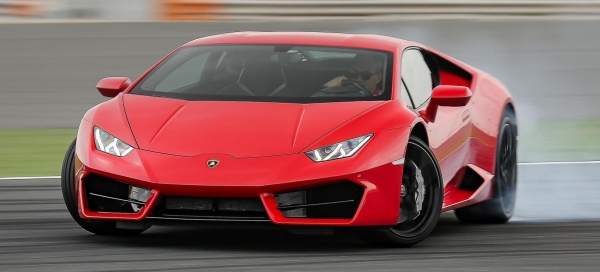 |
|
30
horsepower less and no 4WD, but more fun compensates.
|
|
6 years ago Gallardo
LP550-2 Valentino Balboni proved that less could be more – by
ditching
4-wheel-drive system, the car achieved sharper and more interactive
handling than the standard Gallardo. Thanks to its unexpected
popularity, now the 2-wheel-drive derivative becomes part of the
permanent lineup of Huracan.
As implied by its name, Huracan LP580-2 has its V10 detuned to 580
horsepower, or 30 hp less than the 4WD version. Lamborghini said that
is necessary to avoid overwhelming its traction. 580 vs 610 ponies,
does that make any difference? Ferrari 488GTB and McLaren 675LT have
even more power and torque yet their chassis seem to have no problem to
cope with. The V10 now produces its peak power at 8000 rpm, 250 rpm
lower than before. Likewise, its maximum torque is reduced by 15
pound-foot to 398 lbft. By the way, like the recently updated LP610-4
(or Audi R8), this V10 has added cylinder deactivation technology to
save fuel. CO2 emission is reduced from
290 to 278 grams per km.
On the road, the said reduction of horsepower is not perceptible. This
is still a fabulous V10. It revs and screams madly on wide open
throttle. Maybe it’s not as fast as the aforementioned turbocharged
rivals, but subjectively it feels more thrilling. Moreover, with a top
speed just shy of 200 mph and 0-60 mph time of 3.3 seconds, the LP580-2
is still mighty
fast! Sometimes I wonder why people pursue for performance higher than
this.
Having ditched the front drive shaft, multi-plate clutch and front
differential, the LP580-2 is 33 kg lighter than the 4WD model. It could
have been lighter still if its chassis were designed as an RWD from the
outset. Inevitably, weight distribution is worsened from 43:57 to
40:60, but the point here is a more transparent handling
characteristic. By softening the front suspension a little and using
bespoke wheels and tires, the car has shifted its balance from
understeer to neutral or even oversteer. Driving in Sport mode, the
slightly numb initial response of LP610-4 no longer presents, replaced
with a keener turn-in. If you push it harder in corner, the RWD car
will oversteer readily. Unfortunately, the electronic stability control
is too eager to intervene, and it intervenes abruptly to spoil the fun.
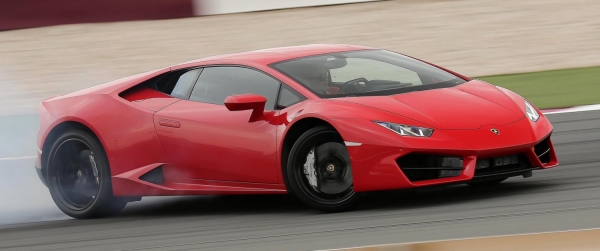 |
|
The
point here is a more transparent handling characteristic...
|
|
Switch to Corsa (race) mode is supposed to raise the
threshold of
electronics, but strangely, it also shifts the balance back to
understeer, though not as severe as Strada mode. Lap time is reduced as
a result of less slippage, but so is the driving excitement. In Corsa
you may turn off the stability control completely, but doing so will
reveal a wayward handling. Lamborghini’s electronics is not as
brilliant as Ferrari’s Side Slip Control, or to lesser extent McLaren's
Brake Steer, which work flawlessly yet invisibly behind the scene.
The same goes for the steering, which is no more feelsome than that of
the 4WD car. Tick the optional active variable steering and it adds an
extra layer of unpredictability.
By ditching the 4WD hardware and
standard ceramic brakes (it uses steel brakes instead), the LP580-2 can
be made 15 percent cheaper than the 4WD model, although Audi R8 Plus
remains a better bargain. It is more fun to drive than both the Audi
and the standard Huracan.
Unfortunately, the flawed electronic control fails to release its full
potential. As a result, it still lives under the shadows of Ferrari and
McLaren.
|
Verdict:     |
Published
on 27
May 2017
|
All rights reserved.
|
|
Huracan Performante
|
|
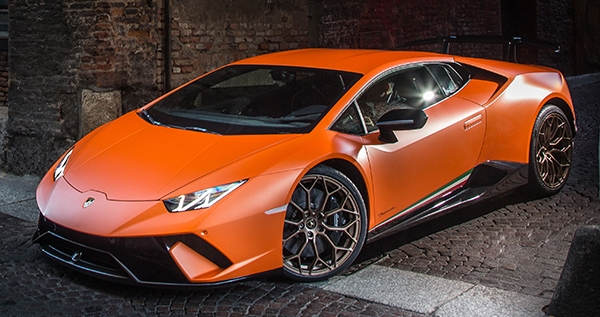
|
|
The
Performante is no longer superlight, but it has more performance than
its name suggested.
|
|
Traditionally, the higher
performance version of small Lamborghini is called Superleggera, which
means superlight. The reason is obvious: the first generation Gallardo
Superleggera cut 100 kg from the standard car even though it retained
the 4WD system, while the second generation model slashed 70 kg for a
1430 kg kerb weight. Unfortunately, as the standard Huracan has already
employed a lot of lightweight carbon-fiber (including part of the
load-bearing chassis), the third generation high-performance small
Lambo manages only 40 kg saving from the standard Huracan, so it has to
abandon the Superleggera label and opted for a new name, Performante.
Its kerb weight is now 1492 kg, heavier than a Ferrari 488GTB and quite
a lot more than McLaren 675LT (1328 kg). Even the aluminum-and-steel
991 GT3 4.0 can undercut it by 62 kg, although you might argue that it
is still remarkably light for a car with a V10 engine and 4-wheel-drive
hardware.
Another thing the Performante unlike its predecessor is that its
production is unlimited, so it will sit permanently above the standard
LP610-4 and LP580-2 in the line-up. Price starts at £213K in the
UK market, compared with £181K of the LP610-4 or £183K of
Ferrari 488GTB. It is hardly a bargain, but considering the performance
it offers, the price is probably worthwhile.
What kind of performance? We are talking about a Nurburgring lap time
of 6:52, beating Porsche 918 Spyder by no less than 5 seconds and is
currently the record holder if you ignore some thinly disguised race
cars or a mysterious electric car that nobody knows if it would be made
into production. Yes, the Performante does that with “only” a naturally
aspirated V10 displacing 5.2 liters, and without any kind of
electrification, so incredible that many doubted its record claims
until Lamborghini released the in-car-cam footage. We’ll dig deeper
into its technical side and see why it could be so fast on track.
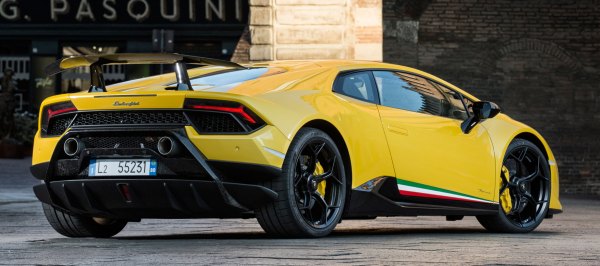 |
|
A
Nurburgring time of 6:52 is incredible for a car with only a naturally
aspirated V10 and without any kind of electrification...
|
|
The Performante looks more aggressive than its siblings
thanks to a number of exterior revisions. Up front, the front splitter
is larger, more pronounced and is arranged in double-plane. Changes to
the side is more subtle, basically limited to blackened sills, door
graphics and a set of ultra-thin-spoke lightweight wheels. More
dramatic is the tail, which includes a high-mounted wing, a massive
diffuser and the exhaust is thoroughly rearranged – now twin
instead of quad-exhaust, mounted higher and closer together to make
room for aerodynamics. Overall, it trades some design purity for
aggressiveness and functions.
Speaking of aerodynamics, the front splitter is active. It incorporates
2 movable flaps, which open to reduce drag and close to enhance
downforce. However, the highlight of the so-called ALA
(Aerodinamica Lamborghini Attiva, or simply Lambo active aero) package
should be the rear wing, which is unquestionably innovative. Most other
supercars use hydraulically adjustable rear wing to alter downforce and
drag to suit driving conditions. The downside is more weight. Unlike
them, ALA uses a fixed carbon-fiber rear wing, but this wing is made
hollow, as are the pair of vertical supports. At the base of each
vertical support, there is an intake duct, which draws air from the
fastback through the inner channel of the hollow support to the hollow
wing. As the channel narrows, the air flow is speeded up and blows out
from the small slots at the underside of the wing. This high-speed jet
stream fills the partial vacuum region behind the wing, altering the
underside air flow and the result is reduced drag. When the movable
flap at the intake duct is closed, no air will be drawn into the wing,
thus its raised angle will guide the air flow upward and generate
downforce. As a result, the ALA wing manages to alter between
high-downforce and low-drag mode without using hydraulic actuators at
the wing. Lamborghini said at high-downforce setting the rear downforce
is increased by 7.5 times over the standard Huracan. Sadly, it did not
reveal the actual downforce figure for either cars, so we have no way
to judge if it can match a, say, 911 GT3 RS.

|
|
ALA
rear wing is innovative in the sense that it is fixed yet variable.
|
|
Another useful trick of the ALA rear wing is the ability to
alter the left and right downforce to help cornering balance, something
like Pagani Huayra. This can be easily implemented by altering the air
flow into each side. In fast bend, the inside half of the wing will be
set to produce more downforce, countering the weight transfer under
g-force and pressing the inside wheel harder to the road. The result is
better grip and less roll. Of course, it doesn't function as well in
slow corners.
To make possible the hollow rear wing and its supports, Lamborghini's forged
carbon-fiber composites made its debut for the first time on
production car. I am not sure if it can better Pagani's carbon-titanium
for strength-to-weight ratio, but it is denser thus allows the wing
components to be made hollow yet strong enough. Speaking of this
state-of-the-art material, the Huracan Performante also uses it to
construct the front splitter, engine lid, rear bumper and diffuser. In
addition to the lighter forged alloy wheels and exhaust, the whole car
is 40 kg lighter.
It could have been lighter still if today's millionaires were willing
to
sacrifice creature comfort like air-conditioning, infotainment system,
carpets and power-everything. Since they don't, the Performante is a
livable supercar. Its cabin is trimmed with Alcantara and carbon-fiber
more for looks than actual weight saving. I still dislike its edgy
design
though. The graphite finish of the carbon-fiber surfaces adds further
flamboyance and distraction.
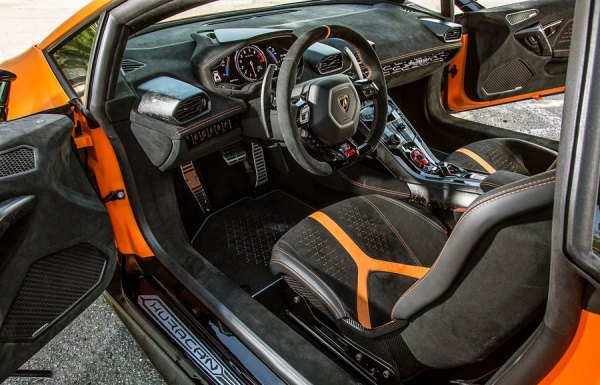
|
|
No
creature comfort sacrificed, and now even more flamboyance.
|
|
Changes to the 5.2-liter V10 are relatively modest. Its
intake manifold and exhaust have been reworked to improve breathing,
while new titanium valves cut weight and lift rev. Valve lift is
increased, too. Brilliantly, these changes don’t make its output any
peakier. Its maximum output is 640 horsepower released at 8000 rpm,
which is 40 hp up and 250 rpm down, while peak torque is increased
by 29 to 442 pound-foot at the same 6500 rpm. Mid-range torque cannot
compete with its turbocharged rivals, of course, but still it offers at
least 70
percent of peak torque from as low as 1000 rpm. 0-60 mph acceleration
is said to be improved by 3/10ths to merely 2.8 seconds, while 0-124
mph is a full second quicker than the standard LP610-4 at 8.9 seconds,
even though it is no match for Ferrari 488GTB (8.3s), let alone the new
McLaren 720S (7.8s). Top speed remains unchanged at 202 mph.
The dual-clutch gearbox, Haldex 4WD system and steering are practically
the same
as before, but they are predictably recalibrated. The suspension is
benefited from stiffer setup – springs and anti-roll bars get 10
percent stiffer, while bushings are 50 percent firmer. One crucial
upgrade contributing to its record Nurburgring lap time is the new set
of Pirelli Trofeo R tires. Yes, the same super-sticky, track-oriented
rubbers fitted to McLaren 675LT and Pagani Huayra BC. Since they wear
out as quickly as Donald Trump
changes his attitude on China, the standard road tires are Pirelli P
Zero Corsa instead.
On the Road
One thing Lamborghini still differs from its rivals is using big
naturally aspirated engines. The 5.2-liter V10 is as free-revving and
responsive to throttle as you can imagine. It can spin to 8500 rpm
accompanied with an angry roar that masks all turbocharged motors. It
offers plenty of torque low down but overall the power delivery is
linear and controlled. The twin-clutch gearbox also seems to change
swifter than the standard car’s, so the gap from Ferrari is closer than
ever. Does the car feel fast? Yes, of course, if not as explosive as
McLaren or Ferrari, but the extra noise makes up the small gap.
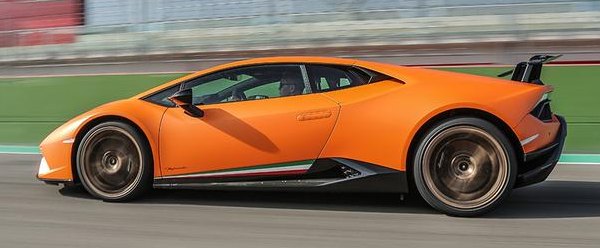 |
|
The
new car feels a lot more precise and confident-inspiring to push to the
limit.
|
|
However, what elevates the Performante to a higher level is
its handling, which is much transformed from the LP610-4. While the
standard car is criticized for too much understeer and too little
driver interaction, the Performante feels sharper, more agile and more
precise. It might be the effect of ALA or the stiffer suspension or the
grippier tires, or most likely the sum of all changes, its turn-in is
noticeably sharper, while understeer is nearly non-existent. The front
Trofeo R tires offer huge amount of grip and keeps the nose on rails.
In Corsa (race) mode, the recalibrated active variable-ratio steering
has replaced its notorious unpredictable manner with a measured
linearity, thanks to a much narrower variation range. As a result, the
new car feels a lot more precise and confident-inspiring to push to the
limit.
On a fast circuit, the Performante flows through corners with minimum
fuss. Its huge grip, downforce and precision suit a fast track.
Predictably, with 4WD it is not as playful as the rear-drive Ferrari,
McLaren or 911 GT3. You can induce oversteer in Corsa mode with heavy
braking in corner entry, but the angle is subtle, and it won’t sustain
for long, because the front wheels will regain traction shortly
afterwards. This manner is unlikely to change until Lamborghini
replaces the Haldex system with something capable of torque vectoring.
As a result, purist drivers will prefer Ferrari and McLaren for their
extra feel, interaction and balance on throttle. The Lambo is built
with a different philosophy: precise, fluent and lose no time in
slipping. It is a very effective track car, and that’s why it can break
Nurburbring record, but it is not necessarily the most exciting to
drive.
On poorer roads, the stiffer suspension inevitably returns a busier
ride, but overall it is still livable enough for day-to-day drives. It
seems to leave some space for a Superleggera derivative to be developed
– what if it slashes more weight by ditching equipment, sound
insulation and using plexiglass windows etc.? and what if Lamborghini
stops chasing lap time and ditches 4WD for more agility? No, I don’t
think that will happen considering how successful its sales now (and
the SUV is just around the corner). Yes, this is a 5-star car in no
doubt, but it is a little bit disappointing to find out that, although
it has finally realized the potential of Huracan, it fails to open a
new era.
|
Verdict:      |
Published
on 19
Mar 2020
|
All rights reserved.
|
|
Huracan Evo
|
|
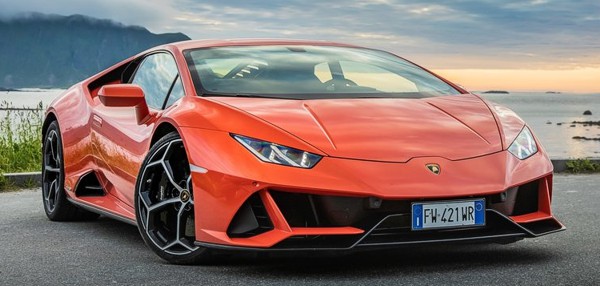
|
|
Small
changes transformed the Huracan into a wonderful driving machine.
|
|
Although the Huracan is 6
years old, there is still some potential left to be exploited. The
outgoing LP610-4 already got countless of technologies, such as a
carbon-fiber-reinforced aluminum spaceframe chassis, a rear-biased
active 4WD system, torque vectoring, magnetorheological dampers, active
variable-ratio steering, a dual-clutch gearbox and a razor-sharp
atmospheric V10. These ingredients lose nothing to its rivals in
Maranello and Woking. Somehow, Sant’Agata has yet to crack the code,
failing to transform these wonderful components into a wonderful
driving experience… until the arrival of Huracan Evo.
Initially, it appears that the Evo is just a small evolution of the
LP610-4, or a production Huracan capitalized the lessons learned from
the now-discontinued Performante special. Yes, its engine is taken
straight
from the Performante. Without increasing capacity, it uses titanium
valves, revised cam profiles, modified intake and exhaust to extract 30
more horsepower from the top end, resulting in 640 hp released at 8000
rpm. Torque output is improved by 29 lbft to 442 lbft. It quotes the
same top speed and 0-60 mph time as the Performante, too, just losing a
tenth to reach 124 mph, since the Evo lacks some of the Performante’s
weight saving measures. For your record, although it is faster than
ever, the turbocharged Ferrari V8 series, now F8 Tributo, and McLaren
720S are
faster still, beating the Lamborghini to 124 mph by more than a second.
It doesn't mean the Lamborghini slow, but the next generation
Lamborghini might need hybrid power to reverse the
game.
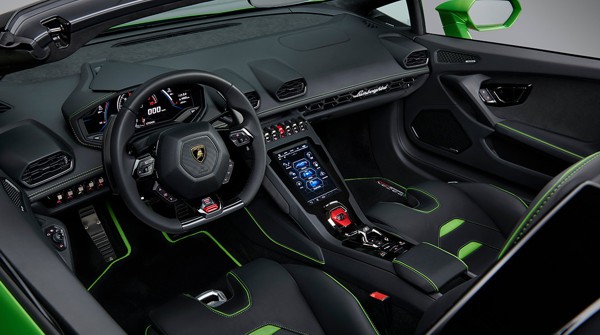
|
|
A
small touchscreen is added to the sloping center console.
|
|
Inside, it gets what you would expect for a mid-life
refresh. The basic architecture remains, but a 8.4-inch portrait
touchscreen is added to the sloping center console. Through that
you can control air con, audio, seat heating and mobile phone
connectivity. However, all the weaknesses of Lamborghini remain,
namely,
poor forward visibility, non-existent rear and rear quarter visibility,
limited space and uncomfortable seats for long journey. Then again,
very few drive Lamborghinis for long distances.
Outside, the Evo sports a restyled front end for improved down force,
while the rear end mirrors the Performante's high-mounted twin exhaust
to make space for a more effective diffuser. Unlike the Performante, it
does without the tricky ALA rear wing. Still, Lambo claims its
aerodynamic efficiency 5 times better than that of the old car.
At the chassis, the most obvious change is the addition of rear-wheel
steering, taken from its bigger brother Aventador. It is supposed to
sharpen turn-in and kill its notorious understeer. Equally important is
the new LDVI (Lamborghini Dinamica Veicolo Integrata) control system
which integrates the rear-wheel steering, active 4-wheel drive, active
variable-ratio steering, stability control, torque vectoring, adaptive
suspension and gearbox under the same processing power. In this way,
different systems can talk to each other through the central brain so
that the latter can predict what happens next. Now they work one in a
piece to realize the desired handling dynamics. Such thing is nothing
new to Ferrari or McLaren, but Lamborghini is finally catching up.
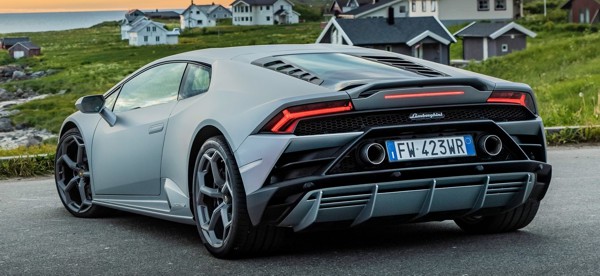 |
|
The
V10 engine, now produces 640hp, remains the highlight of the car.
|
|
On the road, the naturally aspirated V10 is still the
highlight of the car. Wild noise, crazy for rev yet smooth and linear,
it has all the qualities that characterize the best Italian motors in
history, even though it is 2 cylinders short of great. The sharp
throttle response can never be replicated by the turbocharged V8s of
its rivals. Ditto the addictive noise when the V10 revs towards its
8500 rpm redline. While it loses the performance edge, it compensates
with stronger emotion and character.
However, what really surprises in this mid-life refresh is how its
handling is transformed by the rear-wheel steering and integrated
control system. The nose turns into corner more immediately and
incisively. Understeer is banished, replacing it is a neutral attitude.
The car feels better balance in corner. In Sport mode you can induce
oversteer more
easily and hold the power slide. Corsa mode
calms it
down a bit to achieve optimum lap time, whereas Strada mode keeps thing
tidy
and secured. The active variable-ratio steering, now fitted as standard
to all Huracans because it is so matured, feels quick yet consistent in
its response. It
delivers a better sense of what's going on under the front wheels, even
though tactile feedback is still lacking.
The Huracan is never short of traction or grip, especially when
track-focused Pirelli P-Zero Trofeo R tires are fitted. Benefited
further by linear power delivery, it is easy to drive fast. No wonder
the Performante could set Nurburgring lap record. The Evo is not quite
as fast as that car due to its extra weight of 40 kg and reduction of
downforce, but still we expect it will be remarkable on Nurburgring.
For precision and driver engagement, it has the Performante eclipsed.
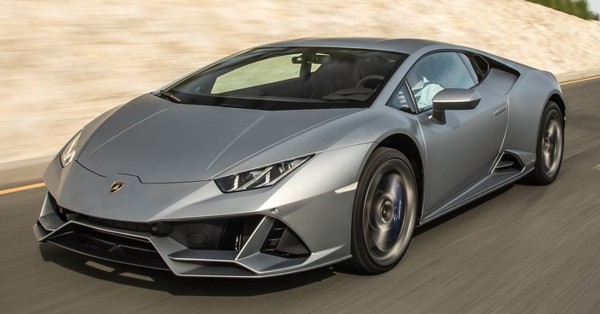
|
|
It
finally engages its driver deeply beyond the wonderful engine
|
|
Is it as good as Ferrari 488 Pista / F8 Tributo or McLaren
720S? Without a back-to-back comparison, it is hard to make the final
judgement. However, if the Huracan Evo loses out, it might be due to
some rough edges. Firstly, it steering is not very communicative.
Secondly,
its turn-in is still not quite as sharp as its rear-drive rivals.
Thirdly, its brake pedal feels spongy in its initial travel. Fourthly,
the ceramic brakes will fade after a few laps of maximum attack,
something won’t happen on its lighter rivals. Fifthly, you cannot
control suspension mode independent of the rest of the chassis, so
Corsa mode is always bundled with a rock hard ride. Lastly
but not least, the poor outward visibility and limited everyday
usability.
The Evo is not a perfect car, but it is closer than ever and, most
important, finally engages its driver deeply beyond the wonderful
engine. While it is not exactly the last word for performance, it is
finally recommendable to keen drivers. Its starting price has increased
from £187,000 to £206,000 to match Ferrari
and McLaren.
|
Verdict:     |
Published
on 15
Apr 2020
|
All rights reserved.
|
|
Huracan Evo RWD
|
|
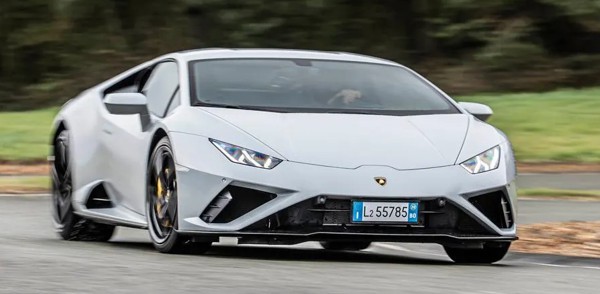
|
|
For
enjoyment on the road, the RWD is slightly better.
|
|
History repeats again. 4
years ago, the LP580-2 was a Huracan ditching the 4-wheel drive system,
cutting 33kg and losing 30 horsepower. The latest Evo RWD is also a
Huracan ditching the 4-wheel drive system, cutting 33kg and losing 30
horsepower. It just lives on a slightly higher performance level, now
610hp, 202 mph and 0-60 in 3.2 seconds. Mind you, it is 4/10ths of a
second slower to 60mph than its 4WD sibling, blame to the combination
of less torque (413 vs 442 lbft) and the lack of front-wheel traction.
Then again, the RWD version is considerably cheaper to purchase, priced
at £165K instead of £200K. In short, an entry-level
Lamborghini.
As before, the RWD is not marketed as a cut-price Lambo, but a purist
model. While the weight reduction is minimal, freeing the front wheels
from driving torque makes the steering lighter and slightly more
transparent – if no match for the hydraulic rack of McLaren. Its
handling is also more predictable and, predictably, feels more
rear-drive. There is a recalibrated traction control to take care of
extreme conditions, but for sure its handling is less secured than the
4-wheel-drive Evo. The smaller, 19-inch wheels it adopted also result
in less roadholding. For maximum track performance, the 4WD is the
better option. For enjoyment on the road, the RWD is slightly better.
However, since the 4WD Evo has its handling massively improved by
rear-wheel steering and LDVI control system, you cannot complain for
understeer anymore. The RWD no longer enjoys an advantage in agility
and precision. In fact, with rear-wheel steering equipped as standard,
the 4WD model is actually the more agile car. Comparatively, the RWD
has a slower, more measured turn-in. More natural you might call, but
it does not feel as sharp to steer as its Ferrari or McLaren rivals.
Also, when it steps beyond its grip limit, it breaks out more abruptly.
Not quite an old-school supercar, but could be more forgiving, given
how versatile its rivals become these days.
In the end, the selling point of Evo RWD remains to be its mighty V10,
whose dramatic sound, razor-sharp throttle response and enthusiasm for
rev are unrivalled by any turbocharged opponents. Its chassis is just
an accessory to the wonderful engine.
|
Verdict:     |
Published
on 26
Sep 2021
|
All rights reserved.
|
|
Huracan STO
|
|
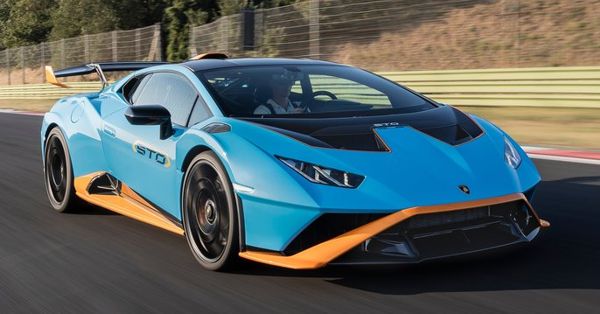
|
|
Lamborghini
farewells its V10 machine with a track weapon.
|
|
Huracan has been with us
since 2014. It is set to be the most successful Lamborghini in history,
with over 17,000 units delivered by now, and likely to reach the 20,000
mark by the time it is replaced with a plug-in hybrid model in 2023.
The days for a naturally aspirated V10 supercar are numbered. What
could be better than bowing out in a high? Lamborghini chose to build
the most racy ever version of Huracan: STO. Super Trofeo Omologata, or
super trophy homologation in English, is benefited from the experience
learned in the one-make series Huracan Super Trofeo Evo and Huracan GT3
Evo race cars. Don’t be fooled by its racy appearance, it is absolutely
road-legal in all major markets. It is not going to be a limited
edition either, because Lamborghini expects most customers will be
happy to switch from the existing Huracan Evo to the STO. In fact, this
year’s allocation has already been sold out, accounting for about 1500
cars. It proves that Sant’Agata has great potential to take a big slice
of the track-oriented supercar market currently dominated by McLaren
and Porsche.
When the Huracan was born 7 years ago, it looked really pure. Over the
years, Sant’Agata made it more and more aggressive through evolutions
and derivatives. It reached a peak in Performante, but compared with
the STO that car looked rather tamed. Like a race car, the STO’s front
end is a one-piece carbon-fiber shell that hinges forward. This gives
easy access to all mechanical as well as a visual linkage to the
classic Miura. A pair of air outlets are opened on the front bonnet to
help cooling the radiators and produce downforce. Bigger front splitter
draws more air towards the underbody and exits at the larger diffusers.
Like Porsche GT3 RS, louvers are added to the top of the front fenders
to release pressure built inside the wheel wells. At the roof, there is
an F1-style snorkel, but here it is used to cool the engine compartment
rather than feeding the airbox directly. Instead, the V10 engine
breaths through a pair of new NACA ducts located at the top of rear
fenders – the latter is made lower to reduce frontal area.
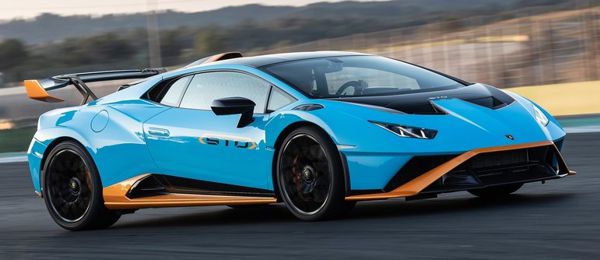
|
|
Race
car tricks generate 420 kg of downforce at 174 mph.
|
|
I suppose the STO cares little about drag or fuel consumption, but it
wants to draw as much air towards the big rear wing. To that end, a
vertical “shark fin” is added behind the snorkel, which helps guiding
air flow to hit the full undersurface of the rear wing even in
high-speed bends. The rear wing is manually adjustable for 3 angles. At
maximum angle, the car can produce 420kg of downforce at 174 mph.
Probably less than the new Porsche GT3 manages (385kg at 124 mph), but
still a very good figure. Lamborghini said it generates 53 percent more
downforce than the Performante, so the racy exterior is meant to
function exactly like it looks. The color-coded skirts and wing
side-plates are just the icing on the cake.
Expectedly, 75 percent of the body work is now made of carbon-fiber
panels. The STO seeks weight reduction also in other obvious areas:
thinner windscreen, magnesium wheels and, most important, ditching the
4-wheel drive system that is skipped in the race cars anyway. In the
cockpit, you will see plenty of weight saving measures as well. The
door panels have been converted to carbon-fiber and its latches are
replaced by fabric pulls. Most surfaces are either exposed carbon-fiber
or Alcantara. Nevertheless, Lamborghini did not go as far as
carbon-fiber seats or ditching infotainment system or air-con. Maybe
the most hardcore Porsche drivers would, but not Lamborghini’s buyers.
They are generally more “showy” kind of millionaires. While few would
actually take their STO to track days, a front trunk specially designed
for helmet storage is considered necessary to show to their friends.
All in all, the STO is 43 kg lighter than Performante. Disappointment?
Yes, considering the loss of front-drive hardware alone should account
for 50 kilos, but “reverse-engineering” rarely gets the desired
results, because you won’t redesign the front chassis. Moreover, the
STO gets the active rear-wheel steering system that was not available
to the Performante. That adds some 8 kilos. Anyway, any modern
supercars weighing just 1450 kg in DIN scale must be considered as a
lightweight.
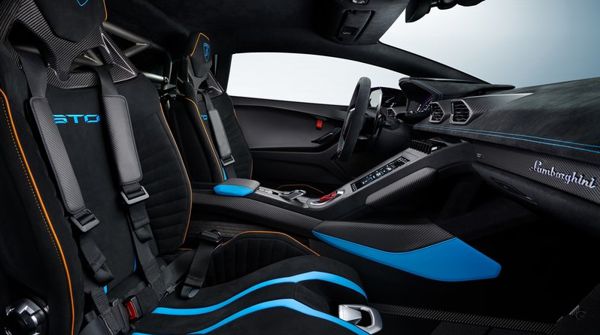
|
|
Despite
extensive use of carbon-fiber and ditching 4WD, the STO is just 43kg
lighter than Performante.
|
|
The chassis gets adequate modifications, too. There are slightly
increased tracks, stiffer suspension bushings, revised anti-roll bars
and retuned magnetic adaptive dampers. The STO uses a conventional
mechanical LSD, but the addition of active rear-wheel steering should
relieve its duty of managing understeer and oversteer. Besides, the
active variable-ratio steering has been ditched for a more predictable
fixed ratio steering, whose ratio is pretty quick. The wheels and tire
sizes are unchanged, but new Bridgestone Potenza Road or Race tires are
chosen to enhance grip. Lastly, the STO is fitted with racing-grade
Brembo CCM-R brakes (also seen in McLaren Senna), which offer 25
percent stronger braking power.
Sadly, there are no physical changes made to the V10 motor. Considering
it is close to retirement age, and Lamborghini boss Stephan Winkelmann
declines to confirm its successor will continue to feature V10, you can
see why Sant’Agata has stopped any meaningful development. If I were
him, I would probably take the same commercial decision as well.
However, from enthusiast point of view, we would love to see a last
push to extract the last drop of its potential before the end of the
pure combustion era. In other words, to bow out on a high and let
everybody remember one of the greatest motors ever made! Somehow,
Lamborghini is
only willing to tweak its ECU for sharper response and sound at higher
revs. The throttle pedal is recalibrated to react more sharply at
initial input, though it could be seen as touchy in urban driving. The
gearshift is remapped to happen more quickly. Maximum power stays the
same as Performante at 640hp, but peak torque is curiously reduced from
442 to 417 lbft, probably not to overwhelm the rear axle. In addition
to the loss of 4-wheel traction, the STO takes a tenth longer in both
0-60 and 0-124 mph acceleration, while top speed is dragged down to 193
mph by those massive aero kits.
Compared to the turbocharged McLaren 765LT and Ferrari 488 Pista, the
Huracan STO is significantly slower in a straight line. It takes 9
seconds flat to go from 0-124 mph, while its rivals take 7.2 and 7.6
seconds, respectively. The new hybrid-power 296 GTB takes 7.3 seconds,
even though it is not designed for race track in the current stage.
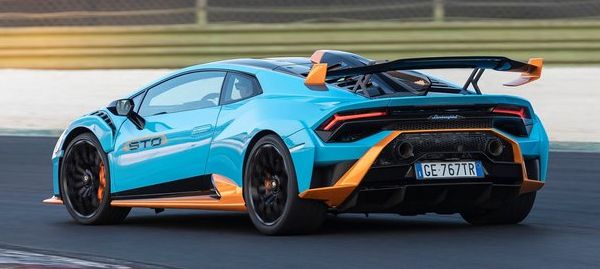
|
|
Great
to drive on track, the best sorted Huracan ever.
|
|
However, in the raw and very loud cockpit, you swear it is at least as
quick as its rivals. The V10 might lack the low-down torque of
turbocharged motors, but it responds instantly to throttle and the rev
counter needle rises and falls quicker than you can follow. Once above
4500 rpm, the exhaust flaps open to an insane level of noise, and the
V10 continues to climb until 8500 rpm is reached. A touch of the
upshift paddle drops the rev momentarily, then climbs quickly again… it
is a joy to work with this linear delivery and the ever-intensifying
noise – an orchestra of induction and exhaust symphony. No turbocharged
motors can replicate this.
There are 3 driving modes: Pioggia is rain mode, STO mode is for road
driving, while Trofeo is for track excitement. On track, the car’s
handling never disappoints. Grip and body control are predictably
excellent. Real downforce helps stability in high-speed bends. The
CCM-R brakes are simply outstanding. But most important, this is the
best sorted Huracan yet, with a sense of lightness, agility, precision
and neutral balance missing in its 4WD siblings. The RWD Huracan has
some of these merits, but the STO takes it to another level of
precision and sharpness. The steering might not be as feelsome as
Porsche GT3 or McLaren, especially at lower speeds where not enough
downforce to load its suspension, but it steers the nose quickly and
accurately. The expert balance of the chassis, the linear power and
instant throttle response allow you to adjust its cornering attitude
precisely. Yes, a 488 Pista can play power slide at massive angles
thanks to the intelligent SSC and active differential, but the STO is a
more focused track car thus it does not promote massive power slide. It
just gives you the necessary amount of slide to adjust attack angle,
then use the traction and grip to help you exit as quickly as possible,
just as a track car should.
On a twisty road with road tires, the STO still maintains that agility
and balance. With no downforce to play, turn-in could feel a little
nervous due to the rear-wheel steering. Get used to this and work the
steering in a more measured way, and the car is just as good to drive.
However, it is no denying that it feels rawer than its Ferrari and
McLaren rivals, as there are more jiggles and tire noise filling the
cockpit. The suspension is very stiff on rough surfaces, although it
improves with speed.
Priced at £260,000, this car sounds expensive for the performance
figures it claimed. However, see it as a farewell edition of
Lamborghini V10, or even the end of the combustion motoring era, and
look at the hybrid V6 of new Ferrari, and you will probably agree it is
worth every penny.
|
Verdict:      |
Published
on 2
Nov 2022
|
All rights reserved.
|
|
Huracan Tecnica
|
|
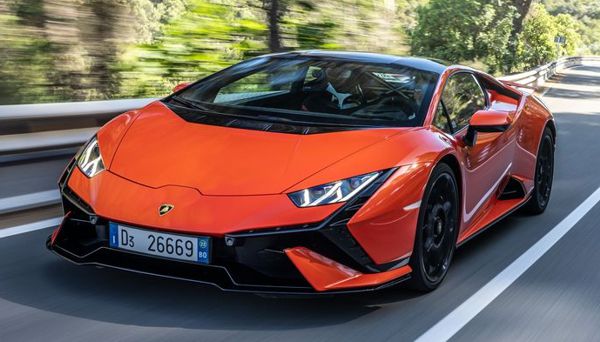
|
|
Not
quite the most exciting Huracan, but probably the most versatile.
|
|
When Lamborghini introduced
the track-oriented Huracan STO last year, it did not expect the new
derivative would be so popular. You know, for a very long time
Lamborghini insisted 4-wheel drive to be one of the core elements of
its cars. That made them approachable to ordinary drivers, but also
robbed them of engagement and thrills that is necessary to match the
very best Ferrari and McLaren. From 2015, Sant’Agata also produces a
rear-drive Huracan, but it is sold as the entry-level model only. It is
the STO that proves rear-drive and track-oriented character can win
even more applause, especially at the top end of the market. This
drives the firm to introduce the second attempt, Huracan Tecnica.
In essence, the Tecnica is a slightly toned down STO, made more
practical for road use as well as cheaper (£212K instead of
£266K). Lamborghini said it bridges the gap between the STO and
Evo RWD, but I would say it is much closer to the former. Take Porsche
for example, if STO is the equivalent of 911 GT3 RS, Tecnica would be
the GT3, while Evo RWD would be a GTS. See the stark contrast between
the last two?
The Tecnica shares the same powertrain with the STO. It is in 640
horsepower tune and drives the rear axle only. As it is more
road-biased, the aero package is not as radical as the STO. The front
luggage compartment is retained, lacking the STO’s top-exit radiator
cooling system. Likewise, the striking rear spoiler of STO is replaced
with a much smaller and lower one, losing a great deal of racing
appeal. The nose and tail design are also different. Up front, it looks
busier with Y-shape black insert at each corner, which is said to
generate air curtain to the side for reduced drag. The top of front
fenders lack the STO’s air vents. The rear deck is very different from
both the STO and the regular Evo, with neither roof-mounted snorkel nor
a glass hatch. Instead, it returns to classic flying buttresses, a
vertical rear window and a flat engine lid that is made of carbon-fiber
but incorporates a glass screen for viewing the beautiful V10. The rear
diffuser is not quite as aggressive as the STO’s. The twin-exhaust gets
hexagonal outlets. Aesthetically, the Tecnica doesn’t look as striking
as the STO.
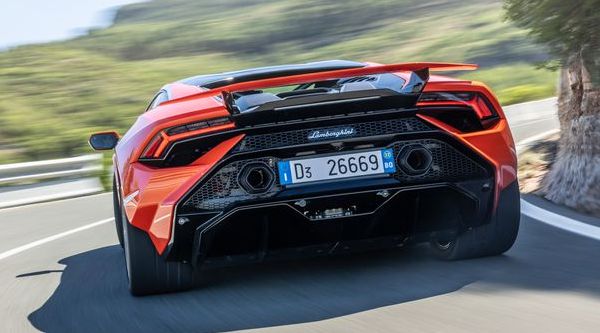
|
|
It
delivers 90% thrills of STO without the compromises in comfort and
usability.
|
|
Obviously, the car does not produce as much downforce as the track
version, but Lamborghini said its aero package generates 35 percent
more rear downforce and 20 percent less drag than the Evo RWD. This
fails to explain why top speed stays at 202 mph though, despite an
advantage of 30 horsepower.
More trustable is acceleration. The car is expected to do 0-60 and
0-124 mph in 3.1 and 9.1 seconds, respectively, 0.2 and 0.1 second
slower than the STO which is 40 kg lighter. The weight difference is
attributed to the lack of carbon-fiber body work (only front bonnet and
engine lid are made of this material), the rear glass windows and the
more luxurious cockpit with proper sound insulation. However, most
buyers are expected to opt for the STO’s carbon-fiber inner door panels
(with fabric door pulls) and carbon-shell bucket seats to cut further
weight.
The chassis setup is slightly softer than that of the STO, but the
tuning philosophy is the same. You still get 4-wheel steering, a
mechanical LSD, adaptive dampers and 3 driving modes (Strada, Sport and
Corsa) to play with. Strada is comfortable enough to take on rougher
roads, Sport is good for normal roads but still tolerable on back
roads, while Corsa is best reserved for flat race track. As a road car,
it is certainly easier to live with than the STO.
Changing the drive mode will also alter the engine sound significantly.
In Strada, it stays quiet until you hit 4500 rpm, when the active
exhaust opens to loud channel. In Sport and Corsa, it is always loud.
Lamborghini’s V10 is still the jewel of the crown. Its exhaust note
when chasing the 8500 rpm redline is intoxicating. Its sharp response
and enthusiasm for rev are well beyond the reach of modern turbocharged
V6s or V8s, so what it loses in outright performance – yes, I know a
Ferrari 296 GTB takes a mind-blowing 7.3 seconds to go from 0-124 mph –
it pays back in sound and feel. At a time when no supercars are deemed
not fast enough, emotional appeal is all the more important. I really
hope Sant’Agata to keep the V10 forever. Unfortunately, if rumors are
true, the successor of Huracan is likely to switch to a hybrid V8 turbo.
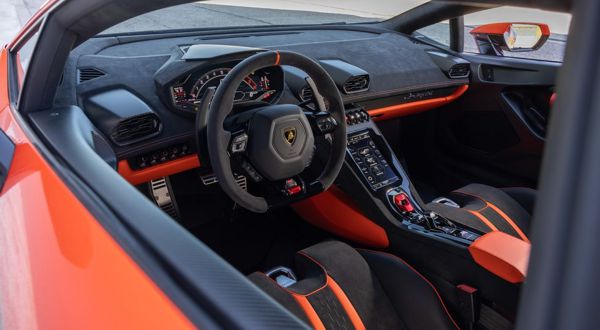 |
|
Lambos
are always bought for their engines, while the rest the cars are given
for free. The fact that the Tecnica has so little compromises in other
areas is already justified for its purchase.
|
|
As for handling, the Tecnica is slightly less sharp than the STO, but
still plenty of fun to have. Driving on a good mountain road, the car
is quick yet very stable. Turn-in is not as pin-sharp as Ferrari or
McLaren, but this is the character of Lamborghini. It corners without
the slightest pitch and roll. Traction and grip is abundance even
without 4WD. The steering is linear and very precise, provides the
necessary information about front-end grip, if not the tactile feedback
of McLaren or Porsche GT3. You can drive it very fast on road without
worrying it bites you back.
In Sport mode, the stability control and rear-wheel steering allow the
rear end to slide more, which gives immense fun, but you really need a
track to access, because the Tecnica needs to be pushed to the extreme
to entertain. Working in tandem with a linear power delivery, razor
sharp throttle and gearshift, power slide cannot come more intuitive.
Corsa mode is actually less fun, because it tightens the 4WS and
stability control to limit slide in the name of optimum track
performance.
The Tecnica is not perfect though. Its steering is not as feelsome as
the STO or some rivals. Its brake pedal has an abrupt response at the
top of its travel. Its stability control intervenes a bit abruptly, not
as invisible as in Ferraris. The ride quality in normal driving, though
respectable for a Lamborghini, is not as remarkable as Ferrari or
McLaren. In those cars, you can adjust the suspension mode independent
of other aspects. Not so in the Lamborghini, where all systems are tied
to the same 3-mode control, so that you cannot have a comfortable ride
while listening to full exhaust opera. The lack of headroom for taller
drivers and poor visibility are also the compromises of Lamborghini.
Judging by objective measures, the car is hard to compete with its
newer, more technically advanced rivals. However, once you have
listened to the crazy howl of its V10, it is hard to forget.
Lamborghinis are always bought for their engines, while the rest are
given for free. The fact that the Tecnica has so little
compromises in other areas is already justified for its purchase. If
you want the driving thrills of STO but expect to spend most of the
driving time on roads, this car will be a perfect alternative.
|
Verdict:      |
|